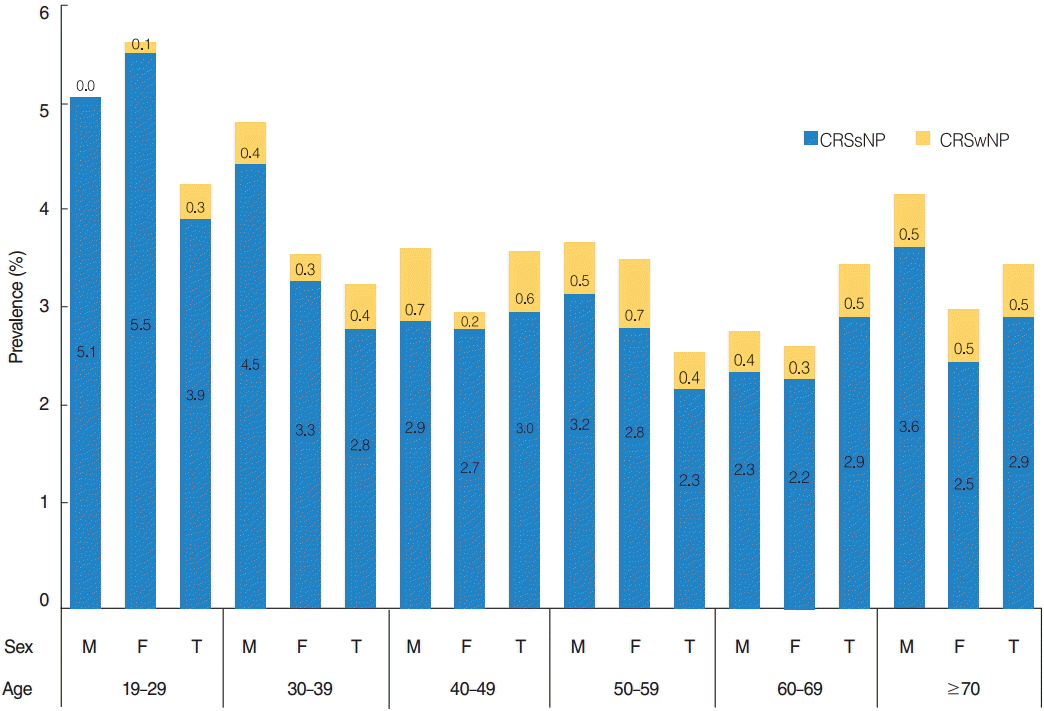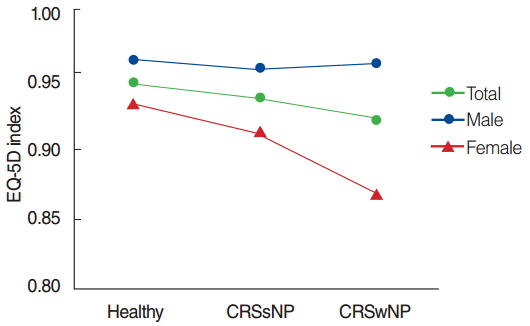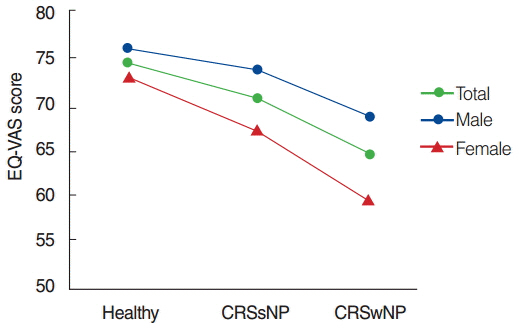Effect of Chronic Rhinosinusitis With or Without Nasal Polyp on Quality of Life in South Korea: 5th Korea National Health and Nutrition Examination Survey Korean
- Affiliations
-
- 1Department of Otorhinolaryngology, College of Medicine, The Catholic University of Korea, Seoul, Korea. kshent@catholic.ac.kr
- 2Department of Biostatistics, The Catholic University of Korea, Seoul, Korea.
- KMID: 2165058
- DOI: http://doi.org/10.21053/ceo.2015.01053
Abstract
OBJECTIVES
This is the first study of its kind to investigate the relationship between chronic rhinosinusitis (CRS) with or without nasal polyps (NP) and health-related quality of life (HRQoL) in the general adult Korean population. We sought to evaluate the association after adjustment for confounding factors. We also evaluated HRQoL according to presence of NP in CRS patients.
METHODS
In this cross-sectional study we used nationally representative samples from the 5th Korea National Health and Nutrition Examination Survey (2010-2012). A total of 17,490 participants were included in the study, of which 613 were diagnosed with CRS. Univariate analysis was conducted on healthy versus CRS groups, segregated by gender with weighted prevalence of demographic characteristics, socioeconomic status, and comorbid diseases. Subanalysis was carried out to evaluate the relationship between CRS with or without NP and HRQoL using EuroQol 5-dimension (EQ-5D) and visual analog scale (EQ-VAS). The odds ratios for EQ-5D were estimated by multiple logistic regression analyses with confounder adjustment.
RESULTS
Weighted prevalence of CRS of adult male was found to be 3.7% and CRS with nasal polyps (CRSwNP) 0.5%, while female CRS was 3.3% and CRSwNP 0.3%. There was no significant difference between the groups (P#x0003d;0.332). The scores for female, EQ-5D index (P for trend<0.001) and EQ-VAS (P for trend=0.002) showed decreasing trend from healthy participants to CRS without nasal polyps (CRSsNP) and from CRSsNp to CRSwNP. After adjusting for demographic characteristics, socioeconomic status, and comorbid diseases, EQ-5D scores; EQ-5D index (P<0.001) and EQ-VAS (P<0.001) exhibited poorer HRQoL compared to healthy participants, exclusively within the female group.
CONCLUSION
These data suggest that female patients with CRS are at higher risk of poor HRQoL. In addition, HRQoL of female CRSwNP was lower compared to those of CRSsNP and healthy participants.
Keyword
MeSH Terms
Figure
Cited by 5 articles
-
Pathogenesis of Recalcitrant Chronic Rhinosinusitis: The Emerging Role of Innate Immune Cells
Il Gyu Kong, Dae Woo Kim
Immune Netw. 2018;18(2):. doi: 10.4110/in.2018.18.e6.Comparison Between Signature Cytokines of Nasal Tissues in Subtypes of Chronic Rhinosinusitis
Dong-Kyu Kim, Kyoung Mi Eun, Min-Kyung Kim, Deuktae Cho, Sun A Han, Sang-Yoon Han, Yuju Seo, Dong-Han Lee, Seong Ho Cho, Dae Woo Kim
Allergy Asthma Immunol Res. 2019;11(2):201-211. doi: 10.4168/aair.2019.11.2.201.New Discoveries Regarding Endotypes of Chronic Rhinosinusitis with Nasal Polyp
Jeong Hwan Yang, Dong-Kyu Kim
Korean J Otorhinolaryngol-Head Neck Surg. 2017;60(9):431-436. doi: 10.3342/kjorl-hns.2017.00045.Bacterial Ball as an Unusual Finding in Patients With Chronic Rhinosinusitis
Dong-Kyu Kim, Young Chan Wi, Su-Jin Shin, Youn Il Jang, Kyung Rae Kim, Seok Hyun Cho
Clin Exp Otorhinolaryngol. 2018;11(1):40-45. doi: 10.21053/ceo.2017.00332.Clinical Practice Guideline: Nasal Irrigation for Chronic Rhinosinusitis in Adults
Do-Yang Park, Ji Ho Choi, Dong-Kyu Kim, Yong Gi Jung, Sue Jean Mun, Hyun Jin Min, Soo Kyoung Park, Jae-Min Shin, Hyung Chae Yang, Seung-No Hong, Ji-Hun Mo
Clin Exp Otorhinolaryngol. 2022;15(1):5-23. doi: 10.21053/ceo.2021.00654.
Reference
-
1. Adams PF, Hendershot GE, Marano MA; Centers for Disease Control and Prevention/National Center for Health Statistics. Current estimates from the National Health Interview Survey, 1996. Vital Health Stat 10. 1999; Oct. (200):1–203.2. Blackwell DL, Collins JG, Coles R. Summary health statistics for U.S. adults: National Health Interview Survey, 1997. Vital Health Stat 10. 2002; May. (205):1–109.
Article3. Collins JG. Prevalence of selected chronic conditions: United States, 1990-1992. Vital Health Stat 10. 1997; Jan. (194):1–89.4. Hastan D, Fokkens WJ, Bachert C, Newson RB, Bislimovska J, Bockelbrink A, et al. Chronic rhinosinusitis in Europe: an underestimated disease. A GA2LEN study. Allergy. 2011; Sep. 66(9):1216–23.5. Kim YS, Kim NH, Seong SY, Kim KR, Lee GB, Kim KS. Prevalence and risk factors of chronic rhinosinusitis in Korea. Am J Rhinol Allergy. 2011; May-Jun. 25(3):117–21.
Article6. Metson RB, Gliklich RE. Clinical outcomes in patients with chronic sinusitis. Laryngoscope. 2000; Mar. 110(3 Pt 3):24–8.
Article7. Rudmik L, Smith TL. Quality of life in patients with chronic rhinosinusitis. Curr Allergy Asthma Rep. 2011; Jun. 11(3):247–52.
Article8. Fokkens WJ, Lund VJ, Mullol J, Bachert C, Alobid I, Baroody F, et al. European position paper on rhinosinusitis and nasal polyps 2012. Rhinol Suppl. 2012; Mar. (23):1–298.9. Choi JY, Ha HS, Kwon HS, Lee SH, Cho HH, Yim HW, et al. Characteristics of metabolically obese, normal-weight women differ by menopause status: the Fourth Korea National Health and Nutrition Examination Survey. Menopause. 2013; Jan. 20(1):85–93.10. Cheng HM, Kim S, Park GH, Chang SE, Bang S, Won CH, et al. Low vitamin D levels are associated with atopic dermatitis, but not allergic rhinitis, asthma, or IgE sensitization, in the adult Korean population. J Allergy Clin Immunol. 2014; Apr. 133(4):1048–55.
Article11. Fokkens W, Lund V, Mullol J; European Position Paper on Rhinosinusitis and Nasal Polyps group. European position paper on rhinosinusitis and nasal polyps 2007. Rhinol Suppl. 2007; Oct. (20):1–136.12. Remenschneider AK, D’Amico L, Gray ST, Holbrook EH, Gliklich RE, Metson R. The EQ-5D: a new tool for studying clinical outcomes in chronic rhinosinusitis. Laryngoscope. 2015; Jan. 125(1):7–15.
Article13. EuroQol Group. EuroQol: a new facility for the measurement of health-related quality of life. Health Policy. 1990; Dec. 16(3):199–208.14. Lee YK, Nam HS, Chuang LH, Kim KY, Yang HK, Kwon IS, et al. South Korean time trade-off values for EQ-5D health states: modeling with observed values for 101 health states. Value Health. 2009; Nov-Dec. 12(8):1187–93.
Article15. Baumann I, Blumenstock G, Zalaman IM, Praetorius M, Klingmann C, Sittel C, et al. Impact of gender, age, and comorbidities on quality of life in patients with chronic rhinosinusitis. Rhinology. 2007; Dec. 45(4):268–72.16. Nanayakkara JP, Igwe C, Roberts D, Hopkins C. The impact of mental health on chronic rhinosinusitis symptom scores. Eur Arch Otorhinolaryngol. 2013; Mar. 270(4):1361–4.
Article17. Hopkins C, Gillett S, Slack R. Are men really more full of SNOT? Clin Otolaryngol. 2009; Jun. 34(3):267–8.
Article18. Katotomichelakis M, Simopoulos E, Tripsianis G, Balatsouras D, Danielides G, Kourousis C, et al. Predictors of quality of life outcomes in chronic rhinosinusitis after sinus surgery. Eur Arch Otorhinolaryngol. 2014; Apr. 271(4):733–41.
Article19. Mendolia-Loffredo S, Laud PW, Sparapani R, Loehrl TA, Smith TL. Sex differences in outcomes of sinus surgery. Laryngoscope. 2006; Jul. 116(7):1199–203.
Article20. Srivastava RM, Rijuneeta , Gupta AK, Patro SK, Avasthi A. Quality of life, disability scores, and distress index in fungal rhinosinusitis. Med Mycol. 2014; Oct. 52(7):706–14.
Article21. Radenne F, Lamblin C, Vandezande LM, Tillie-Leblond I, Darras J, Tonnel AB, et al. Quality of life in nasal polyposis. J Allergy Clin Immunol. 1999; Jul. 104(1):79–84.
Article22. Settipane GA. Epidemiology of nasal polyps. Allergy Asthma Proc. 1996; Sep-Oct. 17(5):231–6.
Article23. Settipane GA, Chafee FH. Nasal polyps in asthma and rhinitis: a review of 6,037 patients. J Allergy Clin Immunol. 1977; Jan. 59(1):17–21.
Article24. Slavin RG. Nasal polyps and sinusitis. JAMA. 1997; Dec. 278(22):1849–54.
Article25. Serrano E, Neukirch F, Pribil C, Jankowski R, Klossek JM, Chanal I, et al. Nasal polyposis in France: impact on sleep and quality of life. J Laryngol Otol. 2005; Jul. 119(7):543–9.
Article26. Collins MM, Pang YT, Loughran S, Wilson JA. Environmental risk factors and gender in nasal polyposis. Clin Otolaryngol Allied Sci. 2002; Oct. 27(5):314–7.
Article
- Full Text Links
- Actions
-
Cited
- CITED
-
- Close
- Share
- Similar articles
-
- Treatment with biological products for chronic rhinosinusitis with nasal polyp
- Update on Biologics in Treatment of Chronic Rhinosinusitis With Nasal Polyposis
- The Role of Allergy in the Severity of Chronic Rhinosinusitis
- Medical treatment according to phenotypes of chronic rhinosinusitis
- Analysis of Nasalance in Patients with Chronic Rhinosinusitis




